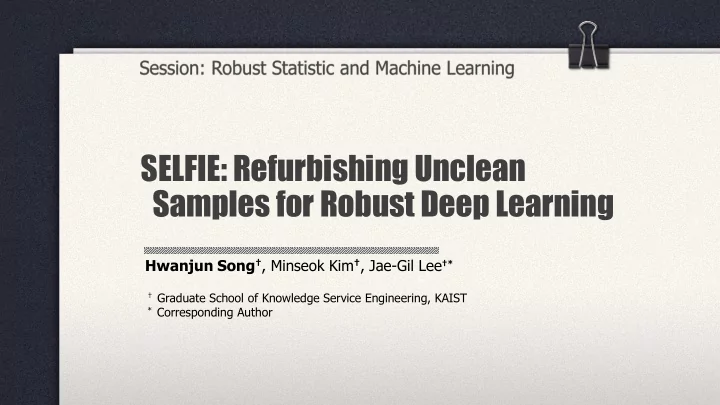

SELFIE: Refurbishing Unclean Samples for Robust Deep Learning Hwanjun Song † , Minseok Kim † , Jae-Gil Lee †* † Graduate School of Knowledge Service Engineering, KAIST * Corresponding Author
• Standard Supervised Learning Setting 𝑂 , 𝒛 𝒋 : True label – Assume: training data {(𝑦 𝑗 , 𝑧 𝑗 )} 𝑗=1 – In practical setting, 𝑧 𝑗 → 𝑧 𝑗 , 𝒛 𝒋 : Noisy label High cost and time consuming Expert knowledge Difficulties of label annotation Unattainable at scale • Learning with Noisy Label – Suffer from poor generalization on test data (VGG-19 on CIFAR-10) 100.0% 100.0% Label Noise Train Error 75.0% 75.0% Test Error 0% 50.0% 50.0% 20% 25.0% 25.0% 40% 0.0% 0.0% 0 25 50 75 100 0 25 50 75 100 Epochs Epochs 2
• Loss Correction – Modify the loss ℒ of all samples before backward step – Suffer from accumulated noise by the false correction → Fail to handle heavily noisy data • Sample Selection (Recent direction) – Select low-loss (easy) samples as clean samples 𝓓 for SGD – Use only partial exploration of the entire training data → Ignore useful hard samples classified as unclean All corrected Selected samples samples (a) Loss correction (b) Sample selection 3
• SELFIE ( SEL ectively re F urb I sh uncl E an samples) – Hybrid of loss correction and sample selection – Introduce refurbishable samples 𝓢 • The samples can be “ corrected with high precision ” – Modified update equation on mini-batch {(𝑦 𝑗 , 𝑐 𝑧 𝑗 )} 𝑗=1 • Correct the losses of samples in 𝓢 • Combine them with the losses of samples in 𝓓 • Exclude the samples not in 𝓢 ∪ 𝓓 1 𝓜 𝒚, 𝒛 𝒔𝒇𝒈𝒗𝒔𝒄 + 𝜄 𝑢+1 = 𝜄 𝑢 − 𝛽𝛼 𝓜 𝒚, 𝒛 𝓢 𝓢 ∪ 𝓓 𝒚∈𝓓∩𝓢 −𝟐 𝒚∈𝓢 𝓓 Corrected losses Selected clean losses 4
• Clean Samples 𝓓 from 𝓝 (mini-batch) – Adopt loss-based separation (Han et al., 2018) – 𝓓 ← 100 − 𝑜𝑝𝑗𝑡𝑓 𝑠𝑏𝑢𝑓 % of low-loss samples in 𝓝 • Refurbishable Samples 𝓢 from 𝓝 – 𝓢 ← the samples with consistent label predictions – Replace its label into the most frequently predicted label 𝒔𝒇𝒈𝒗𝒔𝒄 𝒛 𝒋 → 𝒛 𝒋 Consistent label predictions 𝑦 … dog cat dog dog dog dog dog cat 𝑧 dog (refurbished label) 5
• Synthetic Noise: pair and symmetric – Injected two widely used noises • Realistic Noise – Built ANIMAL-10N dataset with real-world noise Crawled 5 pairs of confusing animals E.g., {(cat, lynx), (jaguar, cheetah),…} Educated 15 participants for one hour Asked the participants to annotate the label – Summary # Training 50,000 Resolution 64x64 (RGB) # Test 5,000 Noise Rate 8% (estimated) # Classes 10 Data Created April 2019 6
• Results with two synthetic noises (CIFAR-10, CIFAR-100) CIFAR-10 CIFAR-100 CIFAR-10 CIFAR-100 (a) Varying pair noises (b) Varying symmetric noises • Results with realistic noise (ANIMAL-10N) (a) DenseNet (L=25, k=12) (b) VGG-19 7
Recommend
More recommend